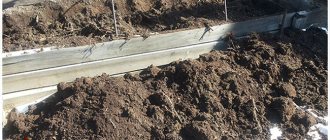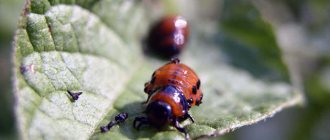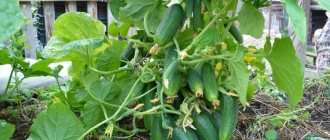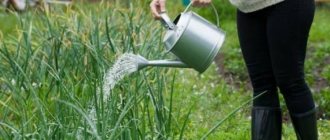Wireworm pest - description
Wireworms are the larvae of a small, up to 15 mm, click beetle. There are many types of different insects, some of which are very dangerous for crops. The larvae of dark and striped beetles damage cereals and sunflowers. Wireworms of black click beetles and tussocks harm vegetables and potatoes. Adult insects themselves are not dangerous to the crop.
Appearance and stages of development
A description of the wireworm will help you recognize the pest. The larvae got their name from their elongated thin body, similar to a wire, 1.5–4.5 cm long. It is difficult to crush the pest, the chitinous cover is so hard. The segmented body has 3 pairs of legs.
Interesting! The literal translation of the name of the beetle larvae from English and German is “wireworm.”
The beetle completes its development in 5 years:
- In May–July, female wireworms lay eggs. Place in piles of 3–5 pieces in cracks in the soil, under lumps, and weeds.
- Larvae appear on average after a month. In the first year of life they are inactive, feeding on the roots of weeds in the place where they hatched.
- The wireworm is dangerous from the second year. Becomes highly active, eats a lot, and grows quickly. From now on, the main food of the larvae is cultivated plants. They look like worms with a chitinous covering of yellow or light brown color.
- The larval stage lasts up to 4 years. Then the grown individual pupates, and the adult beetle emerges in the spring.
Suitable Habitat
There are many types of beetles, pests have adapted to different conditions and live almost everywhere. They choose heavy clayey, moist soils; if such conditions do not exist, they live in any soil. The larvae can be found in the spring almost at the top of the soil, in the summer - their passages are at a depth of 10–20 cm. During drought, they look for moisture and go vertically down. They overwinter, burrowing half a meter into the soil. Pests prefer areas not heated by the sun.
The favorite habitats of wireworms are moist, uncultivated soil overgrown with weeds. They almost always live in fields with creeping wheatgrass, clover, and cereal crops. Pests remain in a young, recently planted garden at the dacha, in new beds after herbs.
In areas with ideal conditions, there are many larvae - from one-year-olds to adults ready to pupate. Continued development helps to completely get rid of wireworms in the garden in 2–3 years. It does not like cultivated land and begins to die en masse.
Reproduction and distribution of insects
From the eggs laid by the female beetle in May–July, under favorable conditions, larvae appear a month later. From one individual to 150. They grow for 3–4 years and overwinter several times. In August, adult larvae turn into pupae, in the spring beetles fly out of them, and the cycle repeats.
It is difficult to remove wireworms from the garden forever for the following reasons:
- numerous offspring from one female - up to 150 larvae;
- longer lifespan compared to other insects;
- underground hidden life.
The larvae have increased vitality due to their rigid body, wintering at a depth of up to 0.6 m. In the spring, with the onset of warmth, adult beetles fly to new areas. Many species, during a period when there is little food, eat leaves, needles of trees, bushes, and feed on pollen.
What plants does wireworm damage?
The wireworm is not a species of insect, but a click beetle larva. The beetles themselves do not cause much harm - they feed on the leaves of cereals. But their females lay up to 100 eggs over the summer, from which a serious enemy of potato plantations emerges - the wireworm.
The larva is a long-liver among insects: if there is food, it can live in the ground for up to 5 years, eating crops. It is difficult to physically destroy a wireworm - it lives underground, breaking through winding passages through which it quickly escapes from the threat.
click beetle and larva (wireworm) enemy of the gardener
2-4 year old individuals are considered dangerous. These wireworms are easily recognized by their clearly segmented body (which makes them look like a worm) with many legs. The length of the larva is 2-3 cm. The color varies from yellow-chestnut to dark brown.
Adult worms have a very thick chitinous shell. It is almost impossible to crush an insect - if you catch a pest, it is easier to tear it apart, cut it into two parts. Although potatoes are considered its favorite food, the wireworm does not disdain almost anything:
- Corn, tomatoes, beets, carrots, onions, cabbage.
- A plant at any stage of development: from seed to fruiting stage, dying.
- Any parts of plantings: root system, fruits, stems, leaves.
The cunning of the pest is that it tolerates wintering well in frozen ground. If you do not control the wireworm this year, the larva will continue to destroy plantings in future seasons.
What harm does it cause to garden and vegetable plantings?
The pest's favorite delicacy is potatoes. Also affected are strawberries, onions, cucumbers, root vegetables, carrots, radishes, and less beets. If the wireworm does not find these crops, it eats other vegetables, corn, melons, sunflowers, cereals, and alfalfa. Gnawing on the roots of grape bushes, garden trees, and flower bulbs.
From the second year of life, the harmfulness of wireworms is activated. Insects quickly dig tunnels, destroying sprouts and roots along the way . Root crops and potatoes are damaged, after which they become unsuitable for storage. The above-ground part of plants with damaged roots dies. Pests carry fungal diseases, which also causes crop death. When the larvae spread massively, more than half of the crop is destroyed.
In the spring there is little food, so wireworms attack the seeds and gnaw, as a result of which they do not germinate (10 ways to combat wireworms on potatoes in the spring).
The larvae damage the roots of young seedlings, which do not have time to take root, wither and die. If there are wireworms in the soil, early radishes are unsuitable for sale - their fruits are eaten away by worms. At this time, pests do not disdain the bulbs of ornamental plants: irises, tulips, gladioli, daffodils. Late-ripening vegetables that have a long growing season suffer the most.
Potato wireworm: what is it?
Wireworms are the larvae of all types of click beetles. Potatoes and other vegetable crops are parasitized mainly by representatives of the genera Limonius, Melanotus, Agriotes, Selatosomus. If the Colorado potato beetle eats potato tops, the wireworm infects the tubers. It is very difficult to determine its quantity on the site, which makes it difficult to destroy the pest.
The appearance of larvae can be detected using the following criteria:
- damaged root system of various vegetables, wheatgrass weed and potatoes;
- passages and rotten areas are clearly visible on the potatoes;
- detection of yellow or brownish worms in the soil;
- reduction in crop yields and plant growth rates.
Attention!
When potatoes are damaged, rotting begins in the soil, which favors the proliferation of pathogenic microorganisms and pests that destroy potatoes. These include nematodes, pathogenic fungi and putrefactive bacteria.
Signs of parasitism on vegetable and fruit crops
The wireworm is an underground dweller. It can be discovered when digging up an area, when the larvae are thrown to the surface.
Secondary signs:
- The seeds do not germinate. When the holes are dug out, damage is visible.
- The seedlings are withering. The parasite eats up young roots, preventing the plant from developing.
- On root crops and potatoes, subtle movements made by the pest are noticeable.
It is difficult to detect wireworms in plantings of potatoes and root crops without tilling the soil or digging up the fruits. The larvae eat individual bushes without going far, and there is practically no permanent damage. Affected plants wilt. Pests are also noticed when loosening the beds, when they appear on the surface.
The peculiarity of wireworms is that they move vertically in the soil, but only slightly in the horizontal direction.
Preventive actions
- Maintain crop rotation that includes legumes. Alternating planted strips of legumes with main crops.
- It is recommended to plant corn, lupine or sunflower between potatoes.
- Autumn digging of the soil to a depth of about 25 cm. The larvae that find themselves on the surface die at low temperatures. Shallow spring digging.
- Liming soil with an acidic reaction. Once every 3 years, add dolomite flour.
- Weed control (wheatgrass).
- Plantings should not be thickened.
- Marigolds and calendula among plantings repel the pest.
- Autumn sowing of mustard as green manure. When the mustard reaches 10 cm, it is cut and embedded in the soil. You can also use sweet clover or buckwheat.
- Timely harvesting. Do not leave unharvested root vegetables in the ground over the winter.
- It is advisable not to import soil from other areas, as it may be contaminated.
The best and effective remedies against wireworms
They begin to fight wireworms in the garden in the spring and continue until late autumn. There are many methods of different effectiveness; choose the most appropriate ones, using them individually or in combination. You can scare away the pest or destroy it, freeing the area from it forever.
Rating of the most effective remedies for wireworms when planting potatoes
Baits and traps against wireworms
In areas allocated for melons or potatoes, baits are made from oat, corn or barley grains for pests. They are soaked in a solution of insecticides “Aktellik”, “Karate”, “Decis” to poison the wireworms. The seeds are dried and sown before plowing or simultaneously with planting. The larvae eat the seedlings and die.
In early spring, pieces of film and planks greased with thick sugar syrup are laid out on the site. Attracted by the sweet smell, the beetles flock and stick. All that remains is to destroy the pests.
Female click beetles are lured into nests made from bundles of hay or straw. They lay eggs there, check traps, and destroy insects. This is done during oviposition, starting in May.
Lure with potatoes:
- Place some chopped tubers at the bottom of half-liter jars or cut-off plastic bottles. Choose shaded places, bury them up the neck - up to 10 cans per hundred square meters. In search of food, beetles crawl into a container from which they cannot get out. After 2–3 days, the pests are collected and the bait is renewed.
- Pieces of potatoes are placed on sticks, deepened by 10–20 cm. After a few days, they are dug up, guided by the ends sticking out from above. The larvae are collected and the procedure is repeated.
- Potatoes are placed on a fishing line and dug in. Pests are collected periodically.
Advice. Wireworms in a trap can be scalded with boiling water so as not to be collected by hand, and fed to poultry.
Folk remedies
In the fight against wireworms, people use methods that repel the pest and make plants unattractive to it. The advantages of traditional methods are accessibility and environmental friendliness.
Onion peel
When planting potatoes, throw a handful of husks into the holes. In strong winds this is inconvenient, so they do it differently. A decoction is prepared and the tubers are soaked in it just before planting. The larvae will not like this, but at the same time, such treatment will protect the plants from some diseases.
Mustard powder
Pour a teaspoon of mustard powder into the holes. If there is too much wireworm, add 1 part ground red pepper. The pest is afraid of the mixture; it also has antibacterial properties and saves plants from diseases.
Needles
Coniferous branches help fight larvae. Use fresh, collecting 1–2 days before planting. Young pine needles have the best properties. They cover the beds with branches, scaring off the smell of larvae.
Potassium permanganate solution
Prepare an aqueous solution - 4 g of the drug per 10 liters. Water the holes the day before planting the seedlings - 0.5 liters per hole. You should be careful when using this method. If the soil is acidic, it is better to refuse - manganese in such conditions can have a harmful effect on plants.
Herbal infusion recipes
To treat the holes before planting, prepare a herbal infusion:
- 100 g dandelion;
- 500 g nettle;
- 200 g coltsfoot.
Green plants are crushed and infused for 3 days in 10 liters of water. Water the holes. A week later the operation is repeated.
Potatoes are soaked in an infusion of celandine or wormwood. Take 100 g of dry grass and infuse it in 10 liters of water for 3 days. The wireworm does not eat processed potatoes.
An effective infusion of garlic: crush 0.5 kg of unpeeled cloves, add 5 liters of water. Leave for 3 hours, dip the potato tubers, dry, and plant. There will be no wireworms or diseases.
Advice! Instead of herbal infusions, you can sow strawberries, marigolds, and calendula in the beds. The flowers are not weeded out; they will grow every year. They have a repellent effect on pests.
Agrotechnical techniques
Agricultural technology is always used to get rid of wireworms, even if the latest chemicals are used.
Reducing soil acidity
The larvae prefer slightly acidic soil – pH 5.5–6.0. If the soil environment is changed to neutral (pH 7), the number of pests will drop by half or more. Female beetles will stop laying eggs in such soil, and after some time the number of larvae will decrease until they disappear completely.
Acidity is changed by adding lime and substances containing it. In small areas, eggshells are placed into the holes. An effective remedy is wood ash or from burning potato tops or sunflower stems. In areas with potatoes, pure lime is not applied - it has the effect of reducing immunity against scab. Better is chalk or dolomite flour, which is scattered before plowing.
Seasonal digging
Spend the summer when beetles lay eggs. They are located at a depth of up to 4 cm, so after digging they end up on the surface. They dry out in the sun and the shells burst. Only the hatched larvae die. It is difficult to accurately determine the time of laying eggs by beetles, so this method is used together with others.
In late autumn, deep digging is carried out so that the larvae die from frost. The disadvantage of this method is that many pests go to great depths for wintering. In addition, wireworms are able to withstand frosts down to -4° for several days.
Site cleaning
A clean area of the site helps reduce the number of pests. Remove weeds, primarily wheatgrass. Remove tops of potatoes, vegetables, remains of tubers and root crops. There should be no food left for the wireworm in the area.
Green manure: sowing grains, legumes, mustard
To improve the soil health, you should sow buckwheat, mustard, and rapeseed. They serve as green manure, and at the same time, wireworms die from lack of food. Their digestive system is not designed to digest such food.
Attention! Among the most effective ways to get rid of wireworms on a site is to sow legumes, which enrich the soil with nitrogen. It forms ammonium cations in the soil, which penetrate the body of pests through chitin. The effect on wireworms is fatal.
Alternation of crops
In areas where potatoes and vegetables are grown, crop rotation is used. Clover, vetch, china, lupine, peas, and beans are sown. Legume seeds can be mixed with oats. If it is not possible to alternate crops, beans and peas are planted between rows.
Reviews and advice from gardeners
Konstantin, 56 years old, Bryansk
A week before planting root crops, we lay out the halves of potato tubers, cut side down, and stick pegs next to them so that we don’t have to look for them later. After 4 days, we collect them along with the larvae and destroy them. In the fall, after harvesting, we lay out heaps of straw, tops and grass on the site, and before the onset of cold weather we collect and burn them along with the wireworms. When digging the soil, we carefully select wireworms from the ground and destroy them in a jar with a solution of salt or vinegar.
Natalya, 68 years old, Belgorod region
I want to share my observations. In soil densely populated with earthworms, there are no wireworms. I think this is due to the fact that worms can destroy clutches of click beetle eggs. I managed to increase the number of earthworms by adding vermicompost to the soil (100-150 g per hole) when planting potatoes. It is known that earthworms destroy pathogenic microorganisms and partially weed seeds. They make the soil loose, so the tubers grow evenly.
Alexander, 44 years old, Vladimir
We began to fight wireworms in a comprehensive manner: we removed the weeds and plowed the garden in the fall and spring. We plant fodder beets along with potatoes. In the fall we harvest and leave the beets until frost. The larvae go into the beets, and after frost we remove them and burn them. We use the ash left after burning wood and add it to the holes before planting potatoes.
Biological and chemical preparations against wireworms
To win the fight against click beetle larvae, pesticides containing diazinon have been created. The most famous insecticide is “Bazudin”. Due to high toxicity, use is recommended when the soil is heavily contaminated. Other similar drugs are “Diazonin 10 RG”, “Medvetox-U”, “Gromoboy-2”, “Pochin”, “Zemlin”, “Grom”. They also act on other pests.
The insecticide “Provotox” is used specifically to destroy wireworms. It does not kill soil microflora and earthworms, and preserves the entire soil ecosystem. The granules are scattered on the ground. By dissolving, they create a protective zone around the plants. The preparations “Prestige”, “Cruiser”, “Select” are used to treat potato tubers before planting.
Biological drugs include Nemabact and Metarizin. The bioinsecticide "Nemabakt" contains nematode worms and special bacteria. Nematodes penetrate the wireworm, and the bacteria kill it. The worm is looking for its next victim. Metarizin contains pathogenic fungi that kill click beetle larvae and are harmless to beneficial soil inhabitants. The powder is dissolved in water and the soil is sprayed.
Conclusions and recommendations
Of course, none of the above methods will provide 100% crop protection. This is not due to the fact that protection measures are not effective, but due to the fact that the beetle can fly to visit at any time and lay eggs. Undoubtedly, the use of preventive protective measures will significantly curb the spread of wireworms.
One of the mandatory ones is the treatment of planting tubers with special solutions before planting (“Prestige”, “Tabu” / “Tabu TRIO” , etc.). I recommend paying special attention to progressive biological methods of protection.
In a separate material, “Processing Potatoes Before Planting,” this is described in detail - what means to use, what are the processing regulations, etc.
*** Changes and additions were made on 09/05/2019.
How to remove wireworms on the site and in the greenhouse
The use of drugs against wireworms has specifics. Granules of diazinon-based insecticides (except Aktara) are applied to the soil during planting. Dosage per 100 m2 plot:
- “Barguzin” – 150 g;
- “Pochin”, “Zemlin” – 300 g;
- “Provotox” – 400 g;
- “Medvetox” – 30 g;
- Aktara solution – 50 g.
Potatoes are protected with the drug “Prestige”. Dissolve in water (ratio 1:15) - enough to treat 10 kg of tubers before planting. Spray evenly and plant immediately. Pre-planting treatment of potatoes is also carried out with insecticides “Cruiser” (20 ml/10 kg), “Select” (40 ml/10 kg).
The drug does not penetrate into young tubers and disintegrates in 40 days.
“Prestige” is used to treat seedlings of peppers, tomatoes, eggplants, and cabbage before planting them in a greenhouse or garden plot. The roots are soaked in a solution (1 ml/100 ml of water) and planted out after 8 hours. Young plants are protected with ammonia. Prepare a solution from 10 ml of the drug and 10 liters of water. Water at the root - 0.5 liters per bush.
Biological drug "Metarizin" liquid. It is diluted: 0.5 l per 10 l of water. Used for watering garden beds on the site and soil in a greenhouse. Use 200 ml of solution per 10 m2.
The nematodes in the biological product “Nemabakt” are in suspended animation and stored in refrigerators. The purchased drug is wrapped in several layers of paper or used for transportation in a cooler bag. The contents of the bioinsecticide package are poured into a bucket of water, the temperature of which corresponds to the ambient temperature. Cover with a mosquito net and monitor the development of worms using a 20x magnifying glass.
When movement is noticeable, you can apply it. The weather should be cloudy or rainy, the temperature should not exceed 26°, the soil should be loose. Water the plants at the root so that the worms do not get on the leaves - they will die from drying out. A bucket of solution is enough for 2 acres of land. After 30 minutes, water with clean water.
Environmentally friendly methods of controlling wireworms
Almost all methods of protection against wireworms are based on making traps for them in one form or another.
Pre-sowing of cereals. About a couple of weeks before sowing potatoes, oats or barley are sown in nests of one and a half dozen grains in the future potato field. After germination, the plants are dug up and wireworms are selected. The method is very labor intensive.
Traps made of rotten organic matter. This is the way to get rid of wireworms in mid-spring, when the frosts have already ended, but the soil is still quite cold. Holes are dug in the soil and half-rotted grass, straw or hay are placed in them. After which the bookmark is watered and covered with boards. Wireworms crawl into organic matter in search of warmth and food. It only takes a couple of days to completely populate the trap with click beetle larvae. After 2 days, the grass is removed and burned. The procedure is repeated several times.
Professional drugs "Etonem" and "Nemabakt". They are not available for retail sale as they are designed for large areas. But perhaps this is the most effective way to protect yourself from click beetle larvae. The preparations are eggs of nematodes, whose main food is wireworm. Able to cope with larvae within one season.
However, Nemabakt is already going into retail sales, which is logical, since the market for private small farmers is actually even larger than the market for large agricultural producers.
Catching click beetles using jam. It is used only in spring, when there are no cultivated plants yet. Diluted syrup from jam, molasses or just sugar is left outside overnight. In the morning, the insects caught in the trap are destroyed, 90% of which are likely to be pests.
How to set up traps for click beetles and wireworms with already planted crops can be seen in the video.
Traps for click beetles and their larvae
Varieties
In total, there are about 12,000 species of click beetles, of which 700-750 are found in the CIS countries. Many varieties of click beetles cause irreparable damage to garden crops.
One of the most common species is the dark click beetle. Its chitin is brown-black, sometimes rusty-brown. The upper elytra are framed by gray hairs. The larvae are yellow-brown and can reach 25 mm in length. The last segment of the wireworm is equipped with dimples similar to spiracles.
The larvae of black click beetle and turf grass mainly damage potatoes and vegetable crops. The larvae of the striped, dark and shiny beetles damage sunflowers and all cereal crops.
An equally dangerous pest is the small click beetle. The length of its body can reach 6-9 mm, width - 1.2-2.8 mm. Chitin is brown in color. It mainly harms grain crops, peanuts, beets, and sunflowers.
The striped (bread) click beetle has an oval elongated body 7-10 mm long. The elytra are dark brown. It feeds mainly on the roots of cereals.
The steppe click beetle damages almost all agricultural crops. The body reaches 9-13 mm in length, the width varies between 2.9-4.5 mm. The head is coarsely punctured. The pronotum is black, the elytra are brownish-black.
Another omnivorous species of beetle is the black click beetle. The body is completely black; a metallic tint may appear. Body length varies between 10-14 mm.
In Central America, there is a species of click beetle that can emit quite bright light. The Indians tied beetles to their legs to light the way at night.
The Parreis click beetle is considered the largest click beetle of the Russian fauna. The length of its body can reach 35 mm. It is included in the register of the Red Book of Russia.
Click beetle: description
Scientists know about more than 2 and a half thousand species of this pest of gardens and vegetable gardens. It can be found almost everywhere, even in the most seemingly unfavorable conditions for it.
The most widespread are steppe, striped and dark beetles. It is extremely difficult to confuse this pest with other types of pests. Adults grow up to 2 cm in length, have an oblong body, and the head occupies almost 2/3 of the body. The beetle may be black, brown or purple in color.
The beetle got its name due to the fact that when it jumps, it makes a sound similar to a click. Therefore, it is easy to distinguish it from other types of pests. You can often see various, rather intricate patterns on the beetle's wings or foredors.
It takes up to 5 years for an egg to develop into an adult click beetle. With the arrival of spring, females climb out of the ground through cracks in the ground, where they lay eggs. They are capable of laying up to one and a half thousand eggs, but for safety, they lay 5 eggs in each hole.
About a month later, voracious larvae emerge from the eggs. The first year of life is characterized by the fact that they do not cause significant damage to the crop, and only in the second year of life can real trouble be expected from them.
The wireworm has a strong body structure, which allows it to easily make thick passages in root crops. During this period, they eat swollen buds, young tubers, shoots and the root system of plants. The larvae pupate over several years and in the spring adult beetles emerge from the pupae, ready for further reproduction.
Appearance of the beetle and place of residence
There are more than 2,500 pests throughout the world. They come in different sizes, from 1 mm (larva) to 2 cm (adult). In the steppe zone they have a bright color - rich brown. It is very difficult to confuse them with other types of insects, but if difficulties arise, you can read the photo and description of what the beetle looks like. Here are the distinctive features and species characteristics:
- pronounced stripes on the back of the click beetle, as in the photo;
- fine hair on the body;
- there are small antennae;
- oblong body;
Note!
Wireworms overwinter in the ground (if there is moisture in it), and in the spring they wake up and go hunting. Of all garden plants, beetles love potatoes the most. They feed on tubers and leaves of the plant, so if at least one parasite is found on a bush, measures must be taken to destroy not only the beetle itself, but also the larvae.
In addition to potatoes, beetles love to eat leaves:
- carrots;
- radishes;
- beets;
- celery;
- cabbage;
- tomato;
- Luke;
- corn.
The main reasons for the appearance of wireworms in potatoes:
- soil acidity;
- soil moisture;
- a lot of vegetation.
The most dangerous time for plants is the beginning of spring until the end of August. During this period, beetles actively spread throughout the garden; if they are not destroyed, the area will soon be completely dried out. Pests are very dangerous for crops.
In the first year of their development, the larvae themselves are not dangerous to plants, since they feed only on leaves and in small quantities. But at 3-4 years of life, the larva’s body hardens, it becomes like a real beetle. Then you need to stock up on various means to combat them. Every gardener should be able to distinguish a healthy bush from one affected by beetles:
- the bush is withered or dried out;
- there are small passages in the potato tuber;
- the larva itself is on the plant, in the ground or in the fruit;
- black spots from piercing passages on the tuber itself.
The fight against wireworms should begin at the first signs of damage.











